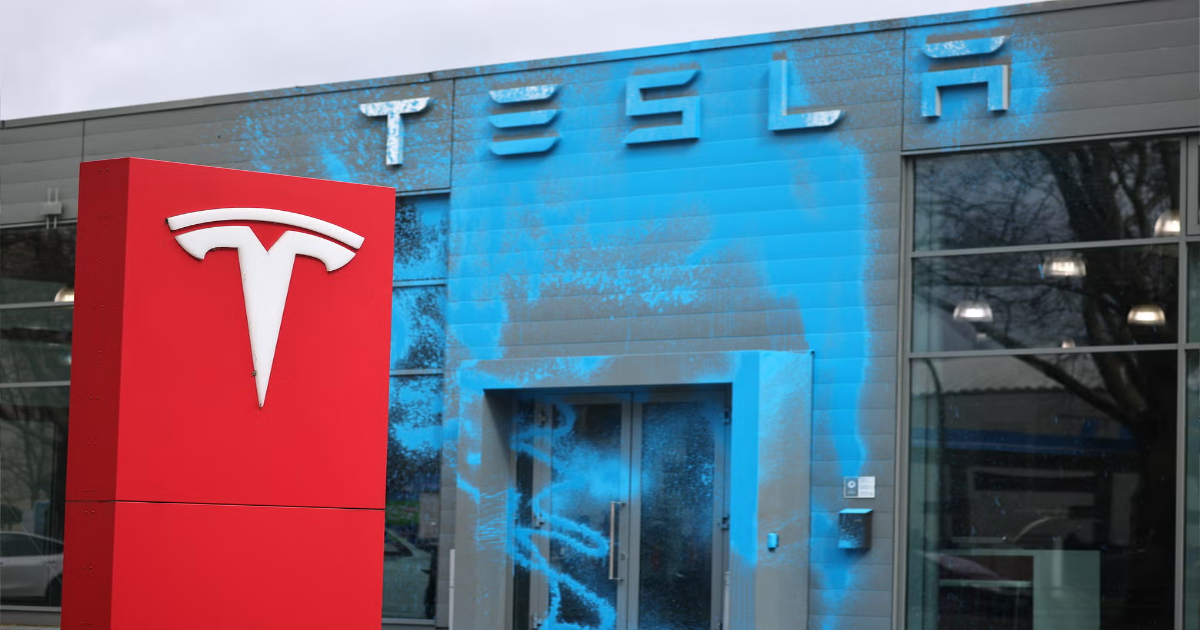Sign up for the Slatest to get the most insightful analysis, criticism, and advice out there, delivered to your inbox daily.
Donald Trump turned the South Lawn of the White House into a Tesla exhibition lot. His attorney general has moved to treat people who destroy Tesla property as domestic terrorists, and Trump has approvingly mused about those vandals going to prison. His commerce secretary went on Fox News and pumped Tesla’s stock directly, telling viewers, “It’ll never be this cheap again.” These events would each make for an earth-shattering corruption scandal in any era other than this one. At this moment, they are all secondary to Trump’s best gift to Elon Musk: appointing him as a governing partner running the nation.
The de facto sale of the executive branch to the world’s richest person may have helped Tesla’s stock recover a bit lately after its second-worst monthly decline ever, in February. But Tesla reported sales for the first quarter on Wednesday, and the numbers drew out a nasty reality for the company: The people who would buy Tesla’s electric cars are, figuratively and now very literally, not buying what Musk is selling.
Tesla is not just selling fewer cars than in recent years, but is also selling fewer than Wall Street thought it was selling. The company delivered 337,000 cars in the first three months of 2025, down from an industry-consensus estimate (compiled by Bloomberg) of 390,000. That was a 13 percent year-on-year drop. Tesla produced 363,000 cars, about 50,000 fewer than the industry thought. Tesla is not the only electric vehicle company struggling to sell cars—its truck competitor, Rivian, is too—but Musk’s company did worse in Q1 at a time when overall auto sales and EV sales were, for most companies, doing better.
The “narrative” about Tesla, as an investment banker might call it, is bleak. Sales are historically lousy, and even some analysts who stayed bullish about the company during its horrible February were sounding a different tune on Wednesday: “This quarter was an example of the damage Musk is causing Tesla,” one of them wrote in a client note. “This continues to be a moment of truth for Musk to navigate this brand tornado crisis and get onto the other side of this dark chapter for Tesla.”
Musk may be taking steps to do that. Tesla’s stock had a bad morning on Wednesday, but it went way up in the afternoon, after Politico reported that Trump had told his Cabinet that Musk would voluntarily leave the government soon. If Musk is actually about to take off the many hats he is now wearing in D.C., that would probably be great for Tesla’s stock, which now has an extensive history of doing poorly when the company’s CEO is in the news for politically polarizing actions like buying Twitter or destroying large swaths of the American government. It would also represent an enormous victory for the people who have spent this winter and spring protesting at Tesla showrooms.
Nobody should lose track of the timing of these events: Tesla released ugly financial numbers in the morning, and a report came out at lunchtime that said Musk would leave government, rallying the stock.
There’s no cure-all, though. For one thing, you may hold off on believing that Musk is actually taking his hands off government operations until you’ve seen definitive proof that he’s gone. (What would that even look like? Probably a mean Truth Social post from Trump, in the event that the two have their long-wished-for-by-liberals falling-out.) For another, a lot of damage to Musk’s reputation, and Tesla by extension, might already be done. Liberals are a lot more likely to buy electric vehicles than conservatives, and there is no indication that Musk has prioritized closing that gap. Some significant percentage of left-of-center people in the United States and abroad will likely be cool on Tesla for a long while even if Musk is all the way gone from government or leaves Tesla itself. The brand association already exists.
Then there are Tesla’s other problems, the ones that get less attention than Musk’s behavior in the political press. The company might be able to avoid the brunt of Trump’s tariffs, for a mixture of reasons that include Musk’s closeness to power and how Tesla organizes its manufacturing. But it won’t be immune from general economic turmoil that results from the tariffs, or persistent questions about the efficacy of its self-driving, or from the ever-accelerating Chinese domestic EV industry biting into its sales.
Other than the tariffs, these are not fresh challenges for Tesla. But they do get more acute when Musk is in the news all of the time for doing things that at least half the world really doesn’t like. The company’s memestock qualities depend on a critical mass of investors believing that Musk has magic business dust. If that belief ever breaks down, Tesla will have to lean on the unusual tactic of actually selling cars.
Maybe that should not be so hard. Musk is arguably now the second most powerful person in the world. The most powerful person has delegated so much to him that you could be forgiven for swapping the order of the two of them. Every conceivable lever of state power (like oversight of agencies that do business with his companies), and even some inconceivable ones (like the president providing free advertising on the White House grounds), have been flipped to benefit him and his largest company. The government can turn itself into a Tesla showroom and endow Tesla property with more protections than it gives to many immigrants. But if the government wants people to buy Teslas they cannot afford or do not want, it will need to do it the honorable, old-fashioned way: by paying for those cars out of the Treasury and then telling everyone that the deal is on the up-and-up.


